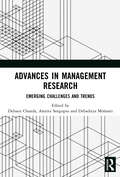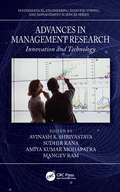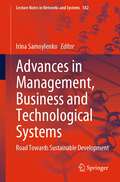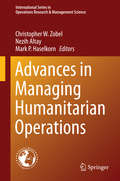- Table View
- List View
Advances in Management Research: Emerging Challenges and Trends
by Debasis Chanda Amrita Sengupta Debaditya MohantiThe purpose of the present edited book ‘Advances in Management Research: Emerging Challenges and Trends’ is to provide a wide range of paradigmatic and theoretical substantive research articles in management research.
Advances in Management Research: Innovation and Technology (Mathematical Engineering, Manufacturing, and Management Sciences)
by Mangey Ram Avinash K. Shrivastava Sudhir Rana Amiya Kumar MohapatraThis book covers advancements across business domains in knowledge and information management. It presents research trends in the fields of management, innovation, and technology, and is composed of research papers that show applications of IT, analytics, and business operations in industry and in educational institutions. It offers a combination of scientific research methods and concepts, with contributions from globally renowned authors; presents various management domains from a number of countries for a global perspective; and provides a unique combination of topics and methods while giving insights on the management domain using a holistic approach. The book provides scholars with a platform to derive maximum utility in the area of management, research, and technology by subscribing to the idea of managing business through performance and management technology.
Advances in Management, Business and Technological Systems: Road Towards Sustainable Development (Lecture Notes in Networks and Systems #582)
by Irina SamoylenkoEconomic development, social sustainability, and environmental protection play a major role in terms of efforts for innovation, digitalization, business, and global development. Today, nations all over the world attempt to accomplish the United Nations Sustainable Development Goals and to ensure sustainable patterns. Combining empirical and theoretical information, this book demonstrates advanced initiatives and concrete examples from universities, research institutes, and companies, regarding cross-cutting issues in sustainable development of a wide range of fields. The major focus in the book is the promotion of quality of life, by means of a more sustainable food production, and improved food security. Additionally, the importance of digital technologies, business policy, social aspects, and corporate governance in ensuring sustainable regional development is studied. This book is a truly interdisciplinary publication, useful to scholars, social movements, practitioners, and members of governmental agencies and private companies.
Advances in Managing Energy and Climate Risks: Financial, Climate and Environmental Sustainable Strategies (Lecture Notes in Energy #82)
by Stéphane Goutte Khaled Guesmi Raphaël Homayoun Boroumand Thomas PorcherThis book presents research related to energy and environmental technologies in the context of market liberalization and global warming. It focuses on the development and efficient use of alternative energy sources, implementation of sustainable energy policies, power generation, and energy finance. Advances in Managing Energy and Climate Risks provides readers with the necessary information to use energy sources more efficiently, discover cleaner energy sources and their applications, and urge consumers and producers to make changes to reach a carbon-neutral economy through financial, technological, regulatory and tax incentives.
Advances in Managing Humanitarian Operations (International Series in Operations Research & Management Science #235)
by Nezih Altay Christopher W. Zobel Mark P. HaselkornThis volume provides a survey of current research problems and results in humanitarian operations research. Additionally, it discusses existing applications of humanitarian operations research, and considers new research efforts that clearly extend existing research and applications. The book is divided into three sections that provide an overview of the subject, a look at the theory, and an examination of applications. The overview section presents chapters on modeling approaches and metrics to evaluate nonprofit operations; chief findings of fieldwork research in disaster response logistics; the use of cash as a form of relief; and measuring markets that supply cash-based humanitarian interventions. The theory section includes chapters that examine the partner proliferation problem in disaster response networks; a case study of humanitarian logistics that examines how humanitarian culture informs change adoption; and a look at the current state of the art for information visibility in humanitarian operations. Finally, the application section focuses on blood products, vaccines, and food assistance, with individual chapters on efficient inventorying and distribution of blood products during disasters; a detailed look at modeling in the context of the vaccine supply chain; a framework for achieving equity, effectiveness, and efficiency in food bank operations; and a spatio-temporal vulnerabili ty assessment of the resilience of a population affected by sudden lack of food.
Advances in Manufacturing (Lecture Notes in Mechanical Engineering)
by Adam Hamrol Olaf Ciszak Stanisław Legutko Mieczysław JurczykThis book covers a variety of topics in material, mechanical, and management engineering, especially in the area of machine design, product assembly, measurement systems, process planning and quality control. It describes cutting-edge methods and applications, together with exemplary case studies. The content is based on papers presented at the 5th International Scientific-Technical Conference (MANUFACTURING 2017) held in Poznan, Poland on 24-26 October 2017. The book brings together engineering and economic topics, is intended as an extensive, timely and practice-oriented reference guide for researchers and practitioners, and is expected to foster better communication and closer cooperation between universities and their business and industry partners.
Advances in Manufacturing Engineering and Materials II: Proceedings of the International Conference on Manufacturing Engineering and Materials (ICMEM 2020), 21–25 June, 2021, Nový Smokovec, Slovakia (Lecture Notes in Mechanical Engineering)
by Sergej Hloch Dagmar Klichová Grzegorz M. Krolczyk Somnath Chattopadhyaya Frank PudeThis book reports on cutting-edge research and technologies in the field of advanced manufacturing and materials, with a special emphasis on unconventional machining process, rapid prototyping and biomaterials. It gathers contributions to the International Conference on Manufacturing Engineering and Materials (ICMEM 2020), which was originally planned in June 2020, but will actually take place in 2021, in Nový Smokovec, Slovakia, because of the Covid-19 pandemic. Despite the challenging times, submitted contributions were peer-reviewed, and upon a careful revision, included in this book, which covers advances that are expected to increase the industry’s competitiveness with regard to sustainable development and preservation of the environment and natural resources. Condition monitoring, industrial automation, and diverse fabrication processes such as welding, casting and molding, as well as tribology and bioengineering, are just a few of the topics discussed in the book’s wealth of authoritative contributions. A special emphasis is given to problems connected to climate change and solution manufacturer and engineers may adopt and develop to prevent and cope with them.
Advances in Manufacturing Engineering and Materials: Proceedings Of The International Conference On Manufacturing Engineering And Materials (icmem 2018), 18-22 June, 2018, Nový Smokovec, Slovakia (Lecture Notes In Mechanical Engineering)
by Sergej Hloch Dagmar Klichová Grzegorz M. Krolczyk Somnath Chattopadhyaya Lucie RuppenthalováThis book reports on cutting-edge research and technologies in the field of advanced manufacturing and materials, with a special emphasis on unconventional machining process, rapid prototyping and biomaterials. Based on the International Conference on Manufacturing Engineering and Materials (ICMEM 2018), held in Nový Smokovec, Slovakia on 18–22 June 2018, it covers advances in various disciplines, which are expected to increase the industry’s competitiveness with regard to sustainable development and preservation of the environment and natural resources. Condition monitoring, industrial automation, and diverse fabrication processes such as welding, casting and molding, as well as tribology and bioengineering, are just a few of the topics discussed in the book’s wealth of authoritative contributions.
Advances in Manufacturing Engineering: Select Proceedings of ICFAMMT 2022 (Lecture Notes in Mechanical Engineering)
by J. Paulo Davim Mithilesh K. Dikshit Ashish SoniThis book presents select peer-reviewed proceedings of the International Conference on Futuristic Advancements in Materials, Manufacturing, and Thermal Sciences (ICFAMMT 2022). The contents of this book provide an overview of the latest research in the area of manufacturing sciences such as metal cutting, metal forming, casting, joining, micromachining, nonconventional machining, and additive manufacturing. Some of the other themes covered in this book are metal-based additive manufacturing, polymer-based additive manufacturing, hybrid additive manufacturing, optimization approach for minimizing GD, and error in additive manufactured parts. The book will be useful for researchers and professionals working in the field of manufacturing engineering.
Advances in Manufacturing Engineering: Select Proceedings of ICFAMMT 2024 (Lecture Notes in Mechanical Engineering)
by Angelos P. Markopoulos Mithilesh K. Dikshit Ashish Soni Navneet KhannaThis book presents the select proceedings of 2nd International Conference on Futuristic Advancements in Materials, Manufacturing and Thermal Sciences (ICFAMMT 2024). It covers the latest research in manufacturing sciences and technology, including metal cutting, metal forming, casting, joining, micromachining, nonconventional machining, and additive manufacturing. The book also covers topics such as industry 4.0, digital manufacturing, and the use of artificial intelligence and machine learning in the manufacturing industry, cryogenic machining, dry and near-dry machining, and additive manufacturing, including metal-based additive manufacturing, polymer-based additive manufacturing, and hybrid additive manufacturing. The book is useful for researchers and professionals working in the field of manufacturing sciences.
Advances in Manufacturing Engineering: Selected articles from ICMMPE 2019 (Lecture Notes in Mechanical Engineering)
by Mokhtar Awang Seyed Sattar Emamian Farazila YusofThis book presents selected papers from the 5th International Conference on Mechanical, Manufacturing and Plant Engineering (ICMMPE 2019), held in Kuala Lumpur, Malaysia. It highlights the latest advances in the area, brings together researchers and professionals in the field and provides a valuable platform for exchanging ideas and fostering collaboration. Joining technologies could be change to manufacturing technologies. Addressing real-world problems concerning joining technologies that are at the heart of various manufacturing sectors, the respective papers present the outcomes of the latest experimental and numerical work on problems in soldering, arc welding and solid-state joining technologies.technologies.technologies.technologies.technologies.technologies.technologies.technologies.technologies.technologies.technologies.
Advances in Manufacturing II: Volume 1 - Solutions For Industry 4. 0 (Lecture Notes in Mechanical Engineering)
by Olaf Ciszak Justyna Trojanowska Ivan Pavlenko José Mendes MachadoThis book covers a variety of topics related to the Industry 4.0 concept, with a special emphasis on the efficiency of production processes and innovative solutions for smart factories. It describes tools supporting this concept in both the mechanical engineering and biomedical engineering field. The content is based on papers presented at the 6th International Scientific-Technical Conference MANUFACTURING 2019, held on 19-22 May 2019, in Poznan, Poland. Virtual reality, simulation of manufacturing systems, additive manufacturing, big data analysis, automation and application of artificial intelligence, as well as economic and social issues related to the integration of those technologies are just some of the topics discussed here. All in all, the book offers a timely and practice-oriented reference guide for researchers and practitioners, and is expected to foster better communication and closer cooperation between universities and their business and industrial partners.
Advances in Manufacturing II: Volume 1 - Solutions for Industry 4.0 (Lecture Notes in Mechanical Engineering)
by Olaf Ciszak Justyna Trojanowska Ivan Pavlenko José Mendes MachadoThis book covers a variety of topics related to the Industry 4.0 concept, with a special emphasis on the efficiency of production processes and innovative solutions for smart factories. It describes tools supporting this concept in both the mechanical engineering and biomedical engineering field. The content is based on papers presented at the 6th International Scientific-Technical Conference MANUFACTURING 2019, held on 19-22 May 2019, in Poznan, Poland. Virtual reality, simulation of manufacturing systems, additive manufacturing, big data analysis, automation and application of artificial intelligence, as well as economic and social issues related to the integration of those technologies are just some of the topics discussed here. All in all, the book offers a timely and practice-oriented reference guide for researchers and practitioners, and is expected to foster better communication and closer cooperation between universities and their business and industrial partners.
Advances in Manufacturing II: Volume 2 - Production Engineering And Management (Lecture Notes in Mechanical Engineering)
by Adam Hamrol Agnieszka Kujawińska Manuel Francisco Suarez BarrazaThis book covers a variety of topics in manufacturing, with a special emphasis on product design, production planning, and implementation of both resources and production processes. The content is based on papers presented at the 6th International Scientific Technical Conference MANUFACTURING 2019, held in Poznan, Poland on May 19-22, 2019. The main focus is on showing best practices to use tools currently available in the enterprises to effectively improving industrial processes. Knowledge and production flow management, decision-making systems, production leveling, enterprise efficiency, as well as maintenance, modeling and simulation of production processes are just some of the topics discussed in this book, which offers a timely and practice-oriented reference guide for applied researchers, product engineers and product managers.
Advances in Manufacturing II: Volume 2 - Production Engineering and Management (Lecture Notes in Mechanical Engineering)
by Adam Hamrol Agnieszka Kujawińska Manuel Francisco BarrazaThis book covers a variety of topics in manufacturing, with a special emphasis on product design, production planning, and implementation of both resources and production processes. The content is based on papers presented at the 6th International Scientific Technical Conference MANUFACTURING 2019, held in Poznan, Poland on May 19-22, 2019. The main focus is on showing best practices to use tools currently available in the enterprises to effectively improving industrial processes. Knowledge and production flow management, decision-making systems, production leveling, enterprise efficiency, as well as maintenance, modeling and simulation of production processes are just some of the topics discussed in this book, which offers a timely and practice-oriented reference guide for applied researchers, product engineers and product managers.
Advances in Manufacturing II: Volume 3 - Quality Engineering and Management (Lecture Notes in Mechanical Engineering)
by Adam Hamrol Marta Grabowska Damjan Maletic Ralf WollThis book covers a wide range of management issues, concerning planning, control and continuous improvement. It especially focuses on the management of the enterprise and production processes in the era of globalization, discussing the process of transferring production to developing countries, covering issues in technological culture, and reporting on quality control issues and on problems related to continuous process improvement. Modern strategies such as Six Sigma and lean manufacturing are also discussed. Another topic concerns the management of the education sphere, and how to develop the latter to prepare employees to the changes brought by the technical development. Based on papers presented at the 6th International Scientific-Technical Conference MANUFACTURING 2019, held in Poznan, Poland on May 19–22, 2019, this book bridges issues in quality engineering with concepts of ergonomics and sociology, thus offering a timely, practice-oriented guide to both the engineers and managers of the future.
Advances in Manufacturing II: Volume 3 - Quality Engineering and Management (Lecture Notes in Mechanical Engineering)
by Adam Hamrol Marta Grabowska Damjan Maletic Ralf WollThis book covers a wide range of management issues, concerning planning, control and continuous improvement. It especially focuses on the management of the enterprise and production processes in the era of globalization, discussing the process of transferring production to developing countries, covering issues in technological culture, and reporting on quality control issues and on problems related to continuous process improvement. Modern strategies such as Six Sigma and lean manufacturing are also discussed. Another topic concerns the management of the education sphere, and how to develop the latter to prepare employees to the changes brought by the technical development. Based on papers presented at the 6th International Scientific-Technical Conference MANUFACTURING 2019, held in Poznan, Poland on May 19–22, 2019, this book bridges issues in quality engineering with concepts of ergonomics and sociology, thus offering a timely, practice-oriented guide to both the engineers and managers of the future.
Advances in Manufacturing II: Volume 4 - Mechanical Engineering (Lecture Notes in Mechanical Engineering)
by Vitalii Ivanov Bartosz Gapiński Marek SzostakThis book covers a variety of topics related to machine manufacturing and concerning machine design, product assembly, technological aspects of production, mechatronics and production maintenance. Based on papers presented at the 6th International Scientific-Technical Conference MANUFACTURING 2019, held in Poznan, Poland on May 19-22, 2019, the different chapters reports on cutting-edge issues in constructing machine parts, mechatronic solutions and modern drives. They include new ideas and technologies for machine cutting and precise processing. Chipless technologies, such as founding, plastic forming, non-metal construction materials and composites, and additive techniques alike, are also analyzed and thoroughly discussed. All in all, the book reports on significant scientific contributions in modern manufacturing, offering a timely guide for researchers and professionals developing and/or using mechanical engineering technologies that have become indispensable for modern manufacturing.
Advances in Manufacturing II: Volume 5 - Metrology and Measurement Systems (Lecture Notes in Mechanical Engineering)
by Magdalena Diering Michał Wieczorowski Christopher A. BrownThis book gathers timely contributions on metrology and measurement systems, across different disciplines and field of applications. The chapters, which were presented at the 6th International Scientific-Technical Conference, MANUFACTURING 2019, held on May 19-21, 2019, in Poznan, Poland, cover cutting-edge topics in surface metrology, biology, chemistry, civil engineering, food science, material science, mechanical engineering, manufacturing, metrology, nanotechnology, physics, tribology, quality engineering, computer science, among others. By bringing together engineering and economic topics, the book is intended as an extensive, timely and practice-oriented reference guide for both researchers and practitioners. It is also expected to foster better communication and closer cooperation between universities and their business and industry partners.
Advances in Manufacturing III: Volume 1 - Mechanical Engineering: Research and Technology Innovations, Industry 4.0 (Lecture Notes in Mechanical Engineering)
by Olaf Ciszak Vitalii Ivanov Bartosz GapińskiThe book covers various topics in mechanical engineering, with a special attention to machine design, product assembly, technological aspects of production, mechatronics and production maintenance. Based on peer-reviewed papers presented at the 7th International Scientific-Technical Conference MANUFACTURING 2022, held in Poznan, Poland, on May 16-19, 2022, the different chapters describe cutting-edge research and methods fostering automation and optimization of industrial processes and machining, with an emphasis on energy-efficient and ecological solutions. All in all, this book offers a timely guide for researchers and professionals in mechanical engineering and manufacturing, yet it is also intended to foster communication and cooperation between universities and industrial partners
Advances in Manufacturing III: Volume 2 - Production Engineering: Research and Technology Innovations, Industry 4.0 (Lecture Notes in Mechanical Engineering)
by Justyna Trojanowska Ivan Pavlenko Agnieszka Kujawińska Jose MachadoThis book reports on cutting-edge research and technology aimed at increasing the efficiency of production processes and to foster the implementation of Industry 4.0 solutions in manufacturing. Gathering peer-review contributions to the 7th International Scientific Technical Conference MANUFACTURING 2022, held in Poznan, Poland on May 16-19, 2022, it describes advanced engineering methods to optimize different stages and aspects of the production process, including product design, production scheduling, equipment maintenance and safety. It discusses the applications of augmented/virtual and mixed reality within the manufacturing industry and for education and training purposes, and highlights cutting-edge solutions for green and sustainable production. Offering a timely, practice-oriented reference guide for both researchers and practitioners in manufacturing, this book is also intended to contribute bridging the gap between university and industry, fostering a closer communication and cooperation between them.
Advances in Manufacturing III: Volume 3 - Quality Engineering: Research and Technology Innovations, Industry 4.0 (Lecture Notes in Mechanical Engineering)
by Adam Hamrol Marta Grabowska Damjan MaletičThis book reports on innovative strategies for quality control, risk assessment and sustainable development in production processes, in the era of industry 4.0. Based on peer-reviewed contributions to the 7th International Scientific-Technical Conference MANUFACTURING 2022, held on May 16–19, 2022, in Poznan, Poland, the chapters cover important topics relating to the use of quality management strategies in different stages of the production processes. They report on methods for statistical process control, vision control and inspection of machines, on the application of machine learning methods in quality control and/or risk assessment, on issues relating to digital transformation, and on methods to improve occupational safety. Besides industrial applications, the book also discusses the use quality management tools for educational purposes. By bridging between concepts in quality engineering, ergonomics, digitalization and industry 4.0, this book offers an authoritative source of information for researchers, engineers and managers.
Advances in Manufacturing III: Volume 4 - Measurement and Control Systems: Research and Technology Innovations, Industry 4.0 (Lecture Notes in Mechanical Engineering)
by Magdalena Diering Michał Wieczorowski Mukund Harugade Alejandro PereiraThis book gathers timely contributions on metrology and measurement systems, across different disciplines and fields of applications. The chapters, which were presented at the 7th International Scientific-Technical Conference, MANUFACTURING 2022, held on May 16-19, 2022, in Poznan, Poland, cover cutting-edge research and best-practices concerning the use of optical, computed tomographic, and coordinate metrology systems to assess the fidelity of 3D printing processes and products. They discuss strategies for automating, and for improving the effectiveness of quality control and measuring processes. All in all, this book provides both researchers and practitioners with a timely guide on cutting-edge measuring systems supporting the development of modern and additive manufacturing in the context of industry 4.0.
Advances in Manufacturing III: Volume 5 - Biomedical Engineering: Research and Technology Innovations, Industry 4.0 (Lecture Notes in Mechanical Engineering)
by Filip Gorski Michał Rychlik Răzvan PăcurarThis book covers a variety of topics at the interface between biomedical engineering and manufacturing. Based on peer-review papers presented at the 7th International Scientific-Technical Conference MANUFACTURING 2022, held in Poznan, Poland on May 16-19, 2022, it focuses on cutting-edge issues relating to 3D printing of medical devices, including custom manufacturing of orthopedic aids, optimization of their manufacturing process, 3D and numerical models supporting prostheses development and surgical simulation, and discusses the applications of different quality control methods in the healthcare industry. This book offers a timely guide to engineers and other professionals dealing with production and testing of medical devices in the era of industry 4.0.
Advances in Manufacturing IV: Volume 1 - Mechanical Engineering: Digitalization, Sustainability and Industry Applications (Lecture Notes in Mechanical Engineering)
by Olaf Ciszak Vitalii Ivanov Bartosz Gapiński Jose Mendes MachadoThe book covers timely topics in mechanical engineering, with a special attention to advances in machine design, product assembly, technological aspects of production, mechatronics and production maintenance. Gathering peer-review contributions to the 8th International Scientific-Technical Conference MANUFACTURING 2024, held on May 14-16, 2024, in Poznan, Poland, it reports on cutting-edge research and methods fostering design processes, optimization of industrial processes, such as welding and molding, and machining, with an emphasis on sustainable solutions. All in all, this book offers a timely guide for researchers and professionals in mechanical engineering and manufacturing, yet it is also intended to foster communication and cooperation between universities and industrial partners.





















